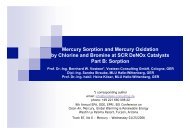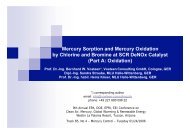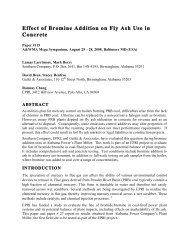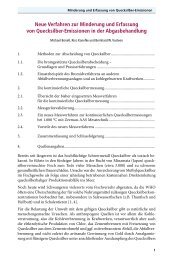08 Vosteen_E_Umbruch - Vosteen Consulting GmbH
08 Vosteen_E_Umbruch - Vosteen Consulting GmbH
08 Vosteen_E_Umbruch - Vosteen Consulting GmbH
You also want an ePaper? Increase the reach of your titles
YUMPU automatically turns print PDFs into web optimized ePapers that Google loves.
Thermal conductivity in W/(m 2 K)<br />
5<br />
4.5<br />
4<br />
3.5<br />
3<br />
2.5<br />
2<br />
1.5<br />
1<br />
0.5<br />
0<br />
Assumed<br />
conductivity<br />
of frozen slag<br />
0 0.5 1 1.5 2 2.5 3 3.5 4 4.5 5<br />
Density in g/cm 3<br />
Density of<br />
frozen slag<br />
Figure 10. Thermal conductivities of heavy and light<br />
refractory bricks at 700 … 800 °C and of air<br />
at 750 °C.<br />
Figure 12 shows the axial profile sslag+brick<br />
(x) as sum of both slag thickness and brick<br />
thickness, the so-called “equivalent brick<br />
thickness”.<br />
The thermographically obtained profiles of<br />
the “equivalent brick thickness” do agree<br />
very well – after primary adaptation of the<br />
(mean) air gap width – with those profiles,<br />
measured directly by drilling.<br />
Drilling must only be done from time to time,<br />
when a kiln has to be cooled down for other<br />
plant-maintenance reasons. Experience has<br />
shown that the air gap width may vary from<br />
kiln to kiln, but doesn’t change much at the<br />
same kiln during its brick life, with the exception<br />
of the first months of operation (brick<br />
settling).<br />
Melting Behaviour of Ashes and Slags<br />
Within the scope of this paper it is not possible<br />
to describe the melting behaviour of<br />
coal ashes (approximately 450 data sets) and<br />
hazardous waste slags (approximately 40 data<br />
sets) in full detail. An extensive report will<br />
be given later in a separate publication. Only<br />
some reference can be made:<br />
As mentioned above, low melting sodiumrich<br />
compounds should be eliminated out of<br />
the solid waste feed as far as possible. Under<br />
high temperature combustion, sodium-halogenides<br />
are rarely found in kiln exit slags,<br />
because they are volatized and transferred –<br />
via evaporation/sulphatation/desublimation –<br />
into the boiler fly ashes. Besides this, the<br />
melting behaviours of coal ashes and hazardous<br />
waste slags are strongly influenced by<br />
— the slag’s iron-content within the slag’s<br />
component-triplet “FeOn – SiO2 – Al2O3”<br />
(well understood as the mass fraction<br />
FeOn / (FeOn + SiO2 + Al2O3), expressed<br />
Total thickness of brick and slag<br />
in mm<br />
in weight-% with<br />
possible values ≥ 0 to<br />
≤ 100 % ) and by<br />
— the “oxidation state”<br />
of the iron oxide FeOn<br />
within the slag’s multicomponent<br />
mixture.<br />
Dissolved Fe2O3 (pure<br />
substance melting<br />
point: 1580 °C) may be<br />
reduced to FeO (pure<br />
substance melting<br />
point: 1390 °C), locally<br />
depending on the<br />
oxidizing or reducing<br />
kiln atmosphere.<br />
The diagrams in Figure<br />
13a (oxidizing conditions)<br />
and Figure 13b<br />
(reducing conditions),<br />
500<br />
400<br />
300<br />
200<br />
100<br />
Thermography of Rotary Kilns<br />
0<br />
0 100 200 300 400 500<br />
Outer shell temperature in °C<br />
VGB PowerTech 9/2002 75<br />
Outer heat transfer coefficient α<br />
W/(m2 K)<br />
70<br />
60<br />
50<br />
40<br />
30<br />
20<br />
10<br />
Total<br />
Thermal radiation<br />
(shell emissivity = 0.95)<br />
Free convection<br />
Figure 11. Outer heat transfer coefficient αoutside (upper<br />
line) by free convection and superimposed<br />
thermal radiation (shell emissivity ε = 0.95).<br />
Equivalent thickness of brick and slag<br />
(thermographical measurement April 28th, 1999)<br />
New brick lining in June 1998<br />
0<br />
0 1 2 3 4 5 6 7 8 9 10 11 12 13<br />
Distance x from kiln entrance in m<br />
Figure 12. Axial profile of the equivalent brick thickness sslag+brick (x) at KILN B, automatically<br />
calculated by „RotaVos“ on April, 28, 1999.<br />
HMP Melting point in °C<br />
under oxidizing conditions<br />
1600<br />
1500<br />
1400<br />
1300<br />
1200<br />
1100<br />
1000<br />
Lignite coal ashes<br />
Hard coal ashes<br />
Hazardous waste slags<br />
0<br />
0 10 20 30 40 50 60 70 80 90 100<br />
Fe 2 O 3 -content within the triplet in weight-%<br />
Figure 13a. Melting-point hammock under oxidizing combustion conditions (half-quantitative<br />
model, based on some 500 data sets, <strong>Vosteen</strong>, 1999).<br />
50<br />
100<br />
CaO-loading of the triplet<br />
in weight-%







